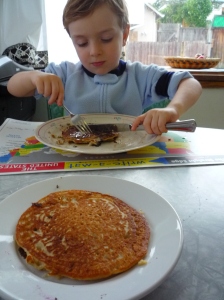These are the easiest and best gluten-free pancakes I have ever made! I’ve tried them all, believe me. I quit making them from scratch because it seemed like they were all too heavy, glue-like, flavorless, sticky or just plain lacking in nutrition.
This recipe is quick, easy, nutritious and best of all DE-LISH!
You will not need a ton of water to wash these down. After eating a huge plate full I still have the energy to face the day!
I adapted this recipe from our local PCC (co-op grocery) newsletter. (recipe by Marie Donadio) There are a few things I changed for my own personal tastes.
Prep time 10-15 minutes!
Ingredients
2 C. Quinoa flour
2 Tbsp. Baking Powder
1/4 tsp. Baking soda
Mix all dry ing. together with whisk in bowl and set aside.
1/2 C. RAW Cashews, soaked 2-3 hours and rinsed well, drained. (be sure to rinse well as raw nuts have an enzyme inhibitor which can make digesting them difficult and lead to stomach pain. Simply soaking and rinsing cures this problem!)
2 C. Filtered Water
1 teaspoon Vanilla Extract (gluten-free, alcohol-free)
1 teaspoon Lemon Juice
1 teaspoon Agave, Honey or Maple Syrup (more to taste as quinoa tends to be a bit less sweet than other flours.)
pinch Sea Salt
Blend all ingredients together in blender two or three times until mixture has a smooth, milky, frothy consistency. You may need to pause to scrape the blades to make sure there are no nut pieces.
(you are essentially making cashew milk!)
Pour liquids over dry ingredients and whisk until no lumps and well blended. If your batter is too thick you can add a touch of water as needed.
I use COCONUT OIL on my cast iron griddle as it is healthy, light and add a super delicious flavor!
We added fresh organic blueberries and spread warm coconut butter and real maple syrup on top! YUM-MY!!
*for variations add shredded or dices apples and cinnamon or fresh fruit. Add flaxseeds into the blender with the cashews for added nutrition.
*For heavier more buckwheat type pancakes simply substitute 1 Cup of the quinoa flour with Buckwheat flour and use 2 TBSP. of baking powder.
For easy ‘whip cream’ to top fruit you can simply blend cashews, macadamia nuts or fresh young Thai coconut meat with coconut water and agave to taste in your blender until smooth and creamy. (If you do not have coconut water you can use a touch of nut milk or water and sweeten with agave, honey or maple syrup.)
